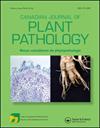Virulence characterization of the wheat stripe rust pathogen, Puccinia striiformis f. sp. tritici, in Turkey from 2018 to 2020
IF 1.5
4区 农林科学
Q3 PLANT SCIENCES
引用次数: 0
Abstract
Abstract Stripe (yellow) rust caused by Puccinia striiformis f. sp. tritici (Pst) is the most devastating disease of wheat in Turkey. Virulence characterization of the Pst population is critical to prevent large-scale epidemics, by developing wheat cultivars with durable resistance against the disease. In this study, 38 Pst races, including 25 races that were not previously reported, were identified from 140 isolates obtained from most regions of Turkey from 2018 to 2020 using a differential set containing 18 single Yr gene wheat lines (NILs) of ‘Avocet’. Virulence to Yr15 was not observed among any of the isolates. Virulence to the remaining 17-Yr genes was detected at various frequencies. The frequencies of virulence to Yr6, Yr9, Yr7, Yr8, Yr43, YrExp2, Yr44, YrTr1, and Yr27 were high (57.1 to 100.0%), to Yr1, Yr17, Yr32, and YrTye were moderate (24.3 to 42.9%), and to YrSP, Yr24, and Yr10 were low (9.3 to 17.1%). Only one race was virulent to Yr5 (0.7%). Many of the races identified were common among regions, indicating that Pst races migrate throughout Turkey. However, the Black Sea (BS) and the Mediterranean (ME) regions were differentiated from other regions by unique races absent in other regions, and the Yr5-virulent race, respectively. To sum up, the virulences of the races identified and their distributions among regions provided an understanding of pathogen migration and may contribute to the development of resistant wheat cultivars against stripe rust.2018年至2020年土耳其小麦条锈病病原Puccinia striiformis f.sp.tritici的毒力特征
摘要小麦条锈病是土耳其小麦最具破坏性的病害。Pst群体的毒力特征对于通过培育对该疾病具有持久抗性的小麦品种来预防大规模流行病至关重要。在这项研究中,从2018年至2020年从土耳其大部分地区获得的140个分离株中,使用包含18个“Avocet”单Yr基因小麦系(NIL)的差异集,鉴定了38个Pst小种,其中包括25个先前未报道的小种。在任何分离株中均未观察到对Yr15的毒力。在不同频率下检测到对其余17个Yr基因的毒力。对Yr6、Yr9、Yr7、Yr8、Yr43、YrExp2、Yr44、YrTr1和Yr27的毒力频率较高(57.1%至100.0%),对Yr1、Yr17、Yr32和YrYe的毒力频率中等(24.3%至42.9%),对YrSP、Yr24和Yr10的毒力频率较低(9.3%至17.1%)。只有一个小种对Yr5具有毒力(0.7%)。鉴定的许多小种在地区间很常见,表明Pst小种在土耳其各地迁移。然而,黑海(BS)和地中海(ME)地区与其他地区的区别分别在于其他地区缺乏的独特小种和Yr5毒力小种。总之,鉴定的小种的病毒性及其在区域间的分布提供了对病原体迁移的了解,并可能有助于开发抗条锈病小麦品种。
本文章由计算机程序翻译,如有差异,请以英文原文为准。
求助全文
约1分钟内获得全文
求助全文
来源期刊
CiteScore
4.50
自引率
5.00%
发文量
56
审稿时长
6-12 weeks
期刊介绍:
Canadian Journal of Plant Pathology is an international journal which publishes the results of scientific research and other information relevant to the discipline of plant pathology as review papers, research articles, notes and disease reports. Papers may be submitted in English or French and are subject to peer review. Research articles and notes include original research that contributes to the science of plant pathology or to the practice of plant pathology, including the diagnosis, estimation, prevention, and control of plant diseases. Notes are generally shorter in length and include more concise research results. Disease reports are brief, previously unpublished accounts of diseases occurring on a new host or geographic region. Review papers include mini-reviews, descriptions of emerging technologies, and full reviews on a topic of interest to readers, including symposium papers. These papers will be highlighted in each issue of the journal and require prior discussion with the Editor-in-Chief prior to submission.

 求助内容:
求助内容: 应助结果提醒方式:
应助结果提醒方式:


